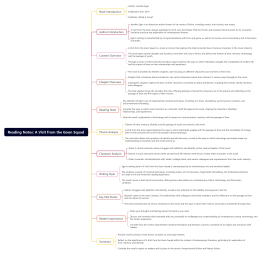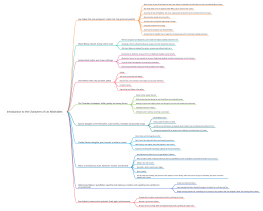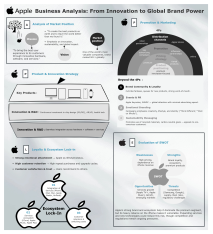
Understanding AmericaOpportunity and Inequality from 1920 to 1973
0 Report
This mind map serves as a comprehensive exploration of 'Understanding America: Opportunity and Inequality from 1920 to 1973.' It delves into the economic and social dynamics of the United States during a period marked by profound change. From the economic prosperity of the Roaring Twenties to the devastating impacts of the Great Depression, the narrative unfolds to include the transformative effects of World War II and the subsequent rise of suburbanization. The map also highlights the persistent struggles for racial and gender equality, illustrating how systemic barriers continued to shape the American Dream for marginalized groups even amid economic growth.
Related Recommendations
Other works by the author
Outline/Content
See more
The Roaring Twenties: A Time of Economic Prosperity
Economic Boom and Consumer Culture
The 1920s, often referred to as the "Roaring Twenties," was a period of rapid economic expansion in the United States. The country experienced significant industrial growth, an increase in mass production, and the widespread adoption of new technologies, such as automobiles and household appliances.
With this economic boom came the rise of consumer culture. For many, life in the 1920s was marked by increased wages, greater access to consumer goods, and the development of a middle-class lifestyle. Popular consumer items like radios, refrigerators, and automobiles were now within reach for a growing number of Americans.
The rise of mass production and new consumer products also led to a culture of credit, allowing more Americans to buy on installment plans. This democratized access to consumer goods, though it also laid the groundwork for future economic instability.
Unequal Distribution of Wealth
However, the prosperity of the 1920s was not experienced equally by all Americans. While industrialists and the wealthy saw enormous gains, a significant portion of the population—especially African Americans, women, and rural communities—remained marginalized.
The agricultural sector, for example, struggled throughout the 1920s. Many farmers were burdened by debt and overproduction, which led to lower crop prices and widespread poverty in rural areas. In fact, much of the nation’s rural farming communities faced economic hardship long before the Great Depression hit.
African Americans faced systemic discrimination and segregation, which severely limited their access to economic opportunities. In the South, the Jim Crow laws enforced racial segregation, and in the North, despite the migration of African Americans to urban centers, discrimination in housing, employment, and education persisted. The notion of the "American Dream" was largely inaccessible to African Americans due to these systemic barriers.
The Great Depression: A Devastating Economic Collapse
Widespread Poverty and Unemployment
The 1929 stock market crash marked the beginning of the Great Depression, one of the most severe economic crises in American history. By the early 1930s, unemployment soared, banks failed, and millions of Americans found themselves living in poverty.
The Great Depression worsened the inequality that already existed in the country, particularly for African Americans, immigrants, and rural populations. Unemployment rates were disproportionately high among African Americans, and discrimination in relief programs limited their access to government aid.
The U.S. saw the rise of "Hoovervilles" (makeshift shantytowns named sarcastically after President Herbert Hoover), where displaced families lived in poverty, demonstrating the stark contrast between the wealthy elite and the destitute masses.
The New Deal: Efforts to Address Inequality
In response to the economic crisis, President Franklin D. Roosevelt’s New Deal programs aimed to provide relief, recovery, and reform to the American economy. The New Deal brought significant changes, such as the establishment of unemployment benefits, public works programs, and Social Security.
While the New Deal brought many positive changes to the U.S. economy, it did not fully address racial inequality. Many African Americans and other minorities were excluded from some of the most important social programs. For example, Social Security initially excluded agricultural workers and domestic workers, many of whom were African Americans.
The New Deal also led to the rise of labor unions, which advocated for better wages and working conditions. While unions helped improve conditions for many, African Americans and women often faced discrimination within organized labor, and their access to New Deal benefits was often limited by local government practices.
World War II: A Turning Point in Opportunity
Economic Mobilization and the War Effort
World War II (1939–1945) marked a significant shift in both economic and social opportunities. The war effort created jobs in factories, shipyards, and military production plants, pulling the United States out of the Depression.
Women, who had been largely excluded from the workforce in the pre-war period, took on roles in factories and other industries as men went off to fight. This shift led to greater participation of women in the workforce, though they still faced unequal pay and workplace discrimination. The iconic image of "Rosie the Riveter" symbolized this new role for women, but it was still a challenging environment where women were expected to return to domestic roles after the war.
African Americans also found new employment opportunities in wartime industries. However, they were often relegated to lower-paying, less skilled jobs and faced severe discrimination in both the military and civilian workforces. Despite this, the war also spurred the development of the "Double V" campaign, a call for victory abroad and at home against both fascism and racial injustice.
The GI Bill and Post-War Opportunities
After the war, the GI Bill (officially the Servicemen's Readjustment Act of 1944) was a key policy aimed at providing opportunities for returning veterans. It provided funding for education, housing, and business loans, which greatly expanded access to higher education and homeownership.
While the GI Bill was a significant opportunity for many white Americans, African Americans and other minorities were often excluded from its benefits. Discriminatory practices in the education system, as well as racial covenants in housing markets, limited the ability of minority groups to fully capitalize on these post-war benefits. The GI Bill reinforced a pattern of inequality, as white veterans were able to access better housing, education, and job opportunities, while African Americans often faced segregation and discrimination when attempting to use the same benefits.
The 1950s and 1960s: The Age of Suburbanization and Civil Rights Struggles
Economic Prosperity and the Rise of Suburbia
The 1950s and early 1960s were marked by economic prosperity for many white Americans. With the rise of suburbanization, homeownership became a symbol of upward mobility. Many Americans, buoyed by a booming economy and the expansion of the welfare state, moved to newly built suburban neighborhoods.
The Federal Housing Administration (FHA) and the GI Bill helped promote homeownership, but these policies often excluded African Americans through redlining and discriminatory lending practices. White families were able to build wealth through homeownership, while African Americans in urban areas faced barriers to buying homes and accumulating generational wealth.
The growth of consumer culture continued, with the automobile, television, and household appliances becoming staples in the average American home. These years marked a period of economic growth and optimism, though not all Americans benefited equally.
Civil Rights Movement: Fighting for Equality
The 1950s and 1960s also saw the rise of the Civil Rights Movement, which sought to address the systemic inequality faced by African Americans, especially in the South. Landmark events like the Brown v. Board of Education decision (1954), the Montgomery Bus Boycott (1955–1956), and the March on Washington (1963) were pivotal in challenging segregation, disenfranchisement, and discrimination.
The Civil Rights Act of 1964 and the Voting Rights Act of 1965 were monumental legal victories, but economic disparities remained entrenched. The passage of civil rights legislation did not automatically translate into economic equality for African Americans. Even with these legislative gains, African Americans still faced significant barriers to achieving full social and economic mobility, especially in urban areas where discrimination in housing, employment, and education persisted.
The 1970s: Economic Stagnation and Rising Inequality
Economic Stagnation
By the early 1970s, the U.S. economy began to experience stagflation—a combination of high inflation and stagnant economic growth. The post-World War II economic boom came to an end as the oil crisis, rising global competition, and shifts in labor markets contributed to economic instability.
The rise of the global economy and the decline of manufacturing industries in the U.S. led to job losses, especially in the industrial heartlands. Many working-class Americans saw their economic prospects diminish, and the gap between the rich and the poor began to widen. Wealth became increasingly concentrated among the top 1% of the population, while wages for the working class stagnated or declined.
The 1970s also marked the beginning of the decline of the American labor movement, as manufacturing jobs were outsourced or lost to automation. This loss of unionized jobs hurt working-class Americans and contributed to the growing inequality of wealth.
Continued Struggles for Minority Groups
The 1970s were also marked by continued struggles for racial and gender equality. Despite the gains of the Civil Rights Movement, African Americans still faced disparities in income, employment, and education. The feminist movement also gained momentum, with efforts to achieve equal pay, reproductive rights, and workplace protections.
The persistence of economic inequality and the failure to fully integrate minorities into the economic mainstream illustrated the limits of American opportunity, despite the legal and social gains of the previous decades. While legal barriers to equality had been dismantled, social and economic barriers continued to restrict opportunities for many.
Conclusion: A Legacy of Opportunity and Inequality
The period from 1920 to 1973 in the United States was one of dramatic change. Economic opportunity grew significantly for many Americans, especially after World War II, and social movements expanded the rights and opportunities available to historically marginalized groups. However, the country’s history of racial, gender, and class inequalities persisted throughout these decades. While many Americans, particularly white middle-class families, experienced rising prosperity, African Americans, women, and other minorities continued to face systemic barriers to full participation in the American Dream.
The 1970s marked the beginning of a new era of economic challenges, but the legacy of inequality and opportunity set the stage for the debates and struggles over economic fairness and social justice that would shape the country in the decades to come.
The story of opportunity and inequality from 1920 to 1973 is not just a history of economic cycles; it is the story of whose opportunities were supported and whose were obstructed. The full realization of the American Dream would take continued struggle and reimagination in the years that followed.

0 Comments
Next Page







